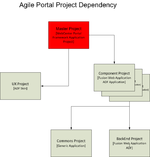Introduction
Let’s first lay out the initial vision for our Ace Portal team. We just parachuted into the Acme Company who recently purchased Oracle WebCenter Portal. They know they need a Portal since Oracle packaged it with their Enterprise Corporate database purchase. The first step to our mission is to create an initial setup of a Portal in an agile development environment. This allows us to gather requirements, deploy small sets of Portlets in a timely fashion, and effectively allow the client to provide feedback throughout the process. A note to all Agile purists (if there is such a thing): this approach may not follow a traditional Agile methodology, however this is how I've successfully deployed WebCenter Portal projects in the past.
Our team will consist of a multifaceted talented set of team members. Titles and skill sets are as follows:
- User Experience (UX) members: ADF Skins developer with CSS3, ADF template, and WCAG/508/ADA experience.
- Middle-tier developers: JSF/ADF components and basic Java bean development experience.
- Back-end developers: ADF business components, database and services skills.
- Content Management Dev/Administrator: A limited license is usually given by Oracle to WCC, however the company might already have an existing CMS in place (i.e. Documentum).
- Administrator Software Configuration Management (SCM): WebCenter Portal Administrator, Oracle Metadata Repository (MDS), Jenkins and ojdeploy Ant task experience.
Now we need to setup our development environment with a project layout that will allow our team to work independently while still deploying on an integrated domain. We must also remember that our Acme client may not have the necessary portal knowledge to effectively communicate the needs of the project’s look-and-feel and portlet details. Therefore, our development team will be deploying various versions in order to receive useful feedback from the client. The client has hinted about having an application that will work with this new database they just bought from Oracle and something like a stock ticker for the CFO. Project Configuration, Continuous Integration, and Build & Deploy systems are needed simultaneously. I like to refer to this group as "The Agile Landscape":
Project Configuration
Let’s get started by splitting out projects into our areas of concern. Guess what? They each match up perfectly with our team setup (this is by design).Project Hierarchy Diagram
Project Descriptions
JDeveloper Project Screenshots
UX ProjectComponents Project
Commons Project
BackEnd Project
Master Project






